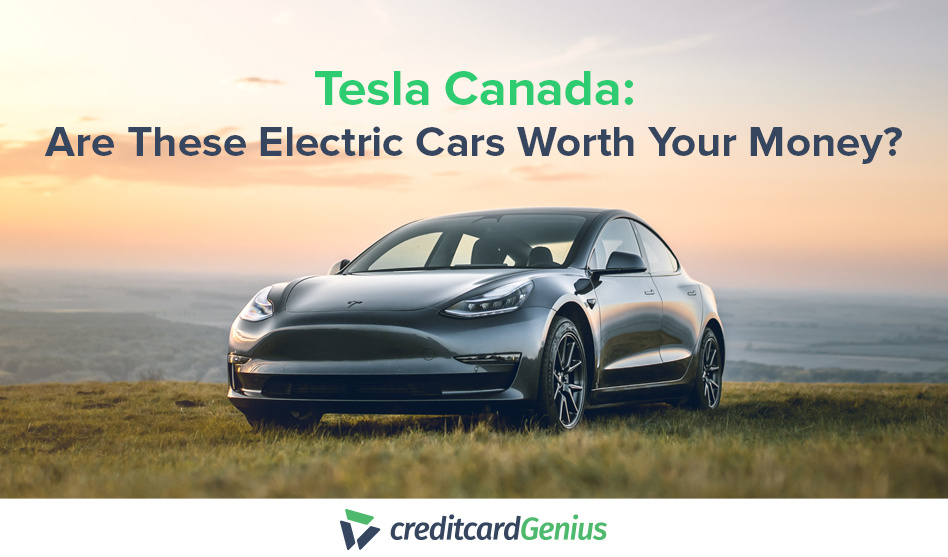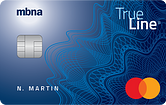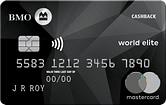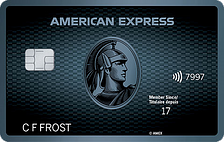If you’re looking to make the switch to an electric car, you’ve probably thought about Tesla.
And Tesla Canada is making this switch easier in so many ways.
First, their supercharger network is a constantly expanding network of fast-chargers, making long-distance travel easier.
Second, the Tesla Model 3 is their attempt to make an affordable sedan. And when you see this thing, you’re gonna want in on the action.
But even beyond the Model 3, Tesla Canada has a lot to offer. Take a look at the Model S, X, Y, or even the Cybertruck (it’s like something out of Back To The Future).
So if you want to make the switch to an electric vehicle (EV), here’s what you need to know.
Never miss an amazing deal again + get our bonus 250+ page eBook for FREE. Join 50,000 other Canadians who receive our weekly newsletter – learn more.
Tesla Canada overview
First coming to Canada in 2012, the Tesla brand is impressive. It’s the option that all electric vehicles are competing with and, in many ways, aspiring to be.
Tesla has revolutionized electric cars and spurred every other car manufacturer to take notice and up their game.
The Tesla Model 3 in particular, marketed as an affordable 4-door family sedan, has been one of the world’s best selling plug-in electric vehicles (PEV) for years.
With the longest range, the coolest features – including self-driving, impressive computing power which allows you to play video games or watch movies, and one of the coolest interiors – and a host of other benefits and products, Tesla offers an electric vehicle unlike any other.
And the best part? They’re offered at even more affordable prices.
Tesla Superchargers in Canada
Tesla superchargers are fast charging stations Tesla has available in mall parking lots and gas stations across the world. Right now, there are more than 2,500 Supercharger Stations with over 25,000 Superchargers available.
The cost and speed of Superchargers can vary, but Tesla is currently advertising that you can get 1,500km worth of charge for $70 – in comparison to $150 equivalent cost of gasoline. They also estimate you only need to charge your Tesla for about 30 minutes to get enough charge to continue your trip.
In Canada, the number of Superchargers available varies from province to province, but you can probably find one near you. You can find the map here.
Tesla financing in Canada
The financing options for Tesla are very flexible and similar to most car dealerships.
Tesla offers lease options ranging from 36 to 96 month terms. The rates are based on your credit score and downpayment, but tend to range from 2.49% to 3%.
Tesla also allows you to finance through a third-party, like your regular financial institution. This makes it easy to compare rates, too. You can check with your bank or shop around for a better rate.
And, of course, you can also pay for your Tesla with cash or lease it for a 48 month term.
Tesla Canada models side-by-side
Tesla makes 5 different battery electric vehicles:
- The Model S,
- Model 3,
- Model X,
- Model Y, and
- Cybertruck (not currently for sale but is available for pre-order).
In addition, each make of Tesla comes in at least 2 different models.
The Model S and Model X come in Long-Range or Plaid models, with the Plaid having an increased top speed of 322km/h.
The Model 3 and Model Y come in Long Range and Performance models, with the Performance model having a slightly higher top speed. The Model 3 has a 3rd model called Standard Range Plus, making it the most affordable Tesla available.
The Cybertruck is still on pre-order in Canada, so Tesla has not listed its price yet. But we do know that it will come in three models: Single Motor RWD, Dual Motor AWD, and Tri Motor AWD.
Here’s a look at the differences between each model, based on their most popular version.
| Tesla Canada Model | Retail Price | Type | Range On A Single Charge | Performance | Extra Features |
|---|---|---|---|---|---|
| Model 3 (Standard Range Plus) | $52,990 | Sedan | 423km | * Acceleration: 0 – 100km/h in 5.6 seconds * Top Speed: 225km/h |
* Optional autopilot * 15″ touchscreen * All glass roof |
| Model S (Long Range) | $114,990 | Luxury Sedan | 652km | * Acceleration: 0 – 100km/h in 3.2 seconds * Top Speed: 250km/h |
* Optional autopilot * 17″ Cinematic display * 10 teraflops processing power for online gaming * 22 speaker, 960-watt sound system * Front and rear trunks for more storage |
| Model Y (Long Range) | $69,990 | Mid-size SUV |
525km | * Acceleration: 0 – 100km/h in 5 seconds * Top Speed: 217km/h |
* Optional autopilot * Dual motor all-wheel drive * 15″ touchscreen * All glass roof |
| Model X (Long Range) | $124,990 | SUV | 580km | * Acceleration: 0 – 100km/h in 3.9 seconds * Top Speed: 250km/h |
* Optional autopilot * Falcon-wing doors * 17″ Cinematic display * 10 teraflops processing power for online gaming * World’s largest panoramic windshield * Choice of 5,6, or 7 seat configuration * 22 speaker, 960-watt sound system |
| Cybertruck | TBA Pre-order only, in Canada. |
Truck | +400km | * Acceleration: 0 – 100km/h in 6.5 seconds * Top Speed: TBA |
* Optional autopilot * +7,500lbs towing capacity * Choice between single motor RWD, dual motor AWD, and tri motor AWD |
Tesla Canada aims to create some of the safest cars on the market. They are proud of their cold-rolled stainless steel frames and they mention that every model is designed to be the safest car on the road.
These cars are full of features, amazing interiors, entertainment systems with up to 17″ screens, and loads of speakers. It’s almost like having a home theatre in your car.
They post impressive accelerations, top speeds, and impressive ranges. Combine all of this with the Supercharger network and you can go from one end of Canada to the other without having to stress. The in-car navigation system will also calculate the Supercharger stops in your route, so you don’t have to worry about doing it yourself.
You should know that the prices listed above are for the lowest-priced models available. The range on each car is as good or better than any other electric car on the market right now. But, to get their long-range, performance models, the price can increase substantially.
For example: the Model 3 starts at $52,990 and increases by $12k to $64,990 for long range. It then jumps $14k to $74,990 if you want the performance model.
Beyond this, if you want your car to drive you everywhere with “Full Self-Driving Capability,” then you can expect to pay an additional $10,600.
Tesla Model 3
This is marketed as the more affordable Tesla. You can see it as the company’s attempt to reach more people with a more approachable price.
Highlights
- The price for the Standard Range Plus model is $52,990, which is still above the Federal EV Rebate price cap
- It can resist the force of 2 elephants standing on the roof
- The 423km range on the base model is just enough to drive all the way from Toronto to Ottawa on a single charge
Read our more detailed review below.
Tesla Model S
The Tesla Model S is a luxury sedan and Tesla’s second car in production after ceasing production on the Tesla Roadster. It’s a fast and well-appointed car with all the bells and whistles.
Highlights
- 0 – 100km/h in 2.1 seconds on the Plaid model
- Impressive 637km range on the Plaid model
- In-car entertainment and gaming with up to 10 teraflops of computer processing power, plus wireless controller compatibility so you can “game from any seat”
Tesla Model X
With more towing capacity than any other electric SUV, the Tesla Model X also has Falcon Wing doors. It combines range, speed, power, and 7-passenger seating.
Highlights
- Falcon Wing Doors
- 2,268kg towing capacity
- 547km range on the Plaid model
Tesla Model Y
The Model Y is a 5 or 7 seat (your choice and at more cost) midsize SUV, with two independent electric motors for all-wheel drive handling in all conditions.
It boasts “unparalleled protection,” up to 525km range, and a low trunk floor with fold-flat seats. These folding seats mean it can handle your bike, skis, or whatever other equipment you want to transport.
Highlights
- The 525km range on the Long Range model is impressive
- Dual Motor AWD for impressive handling
- 0 – 100km/h in 3.7s on the Perfomance model is impressive for an SUV
Cybertruck
Remember watching Back To The Future II for the first time? For many, the film shaped what we thought the future of trucks would look like – and the Cybertruck brings this image to life.
Some like the style, some don’t – but nobody can argue that it has a lot to offer. While the Cybertruck is still in the pre-order phase in Canada, it has some impressive features.
It’s price is currently US$39,900, which currently translates to CA$50,631 – which sounds reasonable when compared to gas or diesel-powered trucks with similar towing and payload capabilities.
Highlights
- 3,500lbs of payload capacity
- 14,000lbs towing capabilities
- Nearly impenetrable exoskeleton
Powerwall
Though this isn’t a Tesla model, the Powerwall is another product you can find on the Tesla Canada website.
Whether you’re building an off-grid home or want back-up power during an outage, this is a fantastic solution. The Powerwall provides 13.5kWh of power. According to NeoVolta, that means the battery can last 13.5 to 16.8 hours.
An added benefit to Tesla Powerwall is that it can reduce your electricity bill. Where communities have time-of-use billing (TOU), Powerwall can store energy during off-peak hours, to be used throughout the day when energy rates are higher.
Highlights
- Real-time control over your home power usage with the Tesla mobile app
- 10-year warranty
- Usage capacity 13.5kWh
- Link up to 10 Powerwall battery energy storage systems
Teslas in Canadian cold weather
Naturally, the (sometimes extreme) cold weather in Canada will affect the range and efficiency of a Tesla. While a Tesla won’t be as affected by low temps as much as many gas-powered vehicles are, according to several myth busters (like this one), it’s still something to consider.
It takes a significant amount of energy to warm up the battery. So much so that some Tesla users claim up to 50% decreased range during the winter. This video does a particularly good job of showcasing how Teslas lose power and range in extremely cold temperatures.
But if you properly prepare your Tesla for our cold Canadian winters, you can avoid such extreme range losses. There are a few things you can do to help prepare your Tesla for use in low temperatures in order to conserve energy and maximize driving range.
Scheduled departure
Tesla recommends using the “Scheduled departure” function on your vehicle’s touchscreen. This is accessed by:
- touching the climate control screen,
- enabling “Preconditioning” in the settings, and
- selecting “Schedule” to set the time the vehicle should be ready to drive every day.
Your Tesla recognizes the set date and time, charges as needed, and prepares accordingly. All of this should be done while your vehicle is plugged in, so it doesn’t use extra unplugged juice.
Prepare with the Tesla app
Installing the Tesla app on your tablet or mobile device allows you to prepare and defrost your Tesla vehicle from inside your home – or wherever you are.
To prepare the vehicle for activity in cold temperatures, you should:
- open the Tesla app,
- go to “Climate” and turn it on, then
- select the defrost icon.
Tesla’s snowflake icon
You’ll notice a blue snowflake icon on your Tesla’s touchscreen if the battery is too cold. This means it can’t access all of its stored energy. It also means you might notice that the battery power and regenerative braking abilities are limited.
The battery can be warmed up fairly quickly by:
- recharging,
- driving, and
- preconditioning your Tesla.
Conserve energy while driving your Tesla
As with most vehicles in Canada during cold weather, there are ways to help reduce energy loss.
To optimize the efficiency and range of your Tesla all year round – but especially during cold Canadian winters – you should:
- drive at moderate speeds,
- avoid and/or limit accelerating and decelerating too quickly,
- use the comfort mode when possible, and
- use the heated seats instead of increasing the in-car temperature.
Tesla charging tips
Here are a few more suggestions for Canadian Tesla owners on how to charge your vehicle for optimal performance during the colder months.
- Use fast charging when the battery is hot. Since the powertrain is what warms the battery while driving, try plugging into a Tesla Supercharger close to your destination. This way, the charge will warm up the battery AND the car.
- Use the navigation feature when heading to a Supercharge station, even if you know the route well. This will prep your Tesla for Supercharging, allowing it to preheat the battery before arrival.
- Leave your Tesla plugged in as much as possible when it’s not being used. This takes the pressure off the battery – instead, the charging system works to conserve heat.
Buying used Tesla in Canada
There are some benefits to buying a used Tesla, especially when you think about battery life. As mentioned in this article, there are Tesla taxis that have travelled more than 300,000 miles and are still kicking.
When looking at EVs, then, a used Tesla might just be the answer.
As it turns out, the Tesla Canada website has a used inventory search menu. It should be noted that the inventory is low – I searched for used Teslas in Montreal and Toronto through Tesla Canada’s website and found none. So, you might have to look to other dealerships.
How to buy used Tesla
The first steps are simple:
1. Check with your local dealerships
Call around and ask if they have any used Teslas in their inventory. Ask them to take down your name and call you if they acquire any in the future.
If you have the time, you can also go to your local dealerships in person. The face-to-face approach can do wonders. Your face is more important than your voice, and the salespeople at dealerships are more likely to remember you and be more invested in helping if you give them a face to go with your name.
Remember to ask questions, like:
- Have you had any used Teslas come across your lot?
- How often?
- What do you know about the warranty remaining on a used Tesla?
This last question is helpful because it tells you how informed your salesperson is. The answer is easily found on Tesla’s support site.
2. Check with online sources
Sites like Autotrader have decent inventories of used Teslas, but they’re spread out across Canada.
You could also check out a website like TeslaDrive.ca. Again, remember that these listings are from all over Canada, so you may need to travel to get the car you want
3. Beware of private sales
Buying from a private citizen is a less secure transaction than buying from a car dealership. That said, you may also save a bunch of money with a private sale.
Dealerships come with a sense of security and reliability – and this is usually factual, not just a feeling – but remember the next step, too.
4. Check the vehicle’s history
Has the vehicle been involved in any accidents or had any major mechanical or technological issues?
Finding this out from the dealer is always a good step when buying a used car, whether it’s electric or not.
5. Double-check the model and included features
This one is important.
In March, a BC couple bought a used 2019 Tesla Model 3 for $46,888. This is a great price, considering the newer models cost over $52k, but there was an issue:
“The advertisement stated the vehicle had autopilot as an option. However, when they got the vehicle home they discovered it did not have the enhanced autopilot feature they thought they had paid for” (CTV News).
The auto-pilot was an option. This is important.
Auto-pilot is always an option with Teslas – “option” meaning that it doesn’t always come with it. You have to purchase it. And it costs $10,600 extra to add.
This couple wasn’t aware of the fact that having the auto-pilot option does not mean that you have auto-pilot. Extra payment is required to get this feature.
And since each Tesla has at least 2 different sub-models, it’s important to get the info on the model you’re buying.
Is it Standard Range, Long Range, Performance, or Plaid?
Each of these versions of your car have a different price-point. It can vary by $10 – $20k or more and affects performance and range.
Be sure of what you are getting.
6. Settle on a price that is reasonable
Just because you’re buying a fancy Tesla doesn’t mean you aren’t still buying a used car at the end of the day.
And the value of cars depreciates. For example, a 2-year-old used vehicle will have lost almost 30% of its value – around 20% is lost in the first year, and about 10% every year after.
For this reason, you can aim to pay 20% – 30% less for a 2-year used car than a new one. This means you’re getting a fairly new car, without taking the hit of depreciation yourself.
With this in mind, let’s look at the example above. The couple in BC paid $46,888 for a 2019 Tesla Model 3. A new one costs between $52,990 and $74,990. This means they paid 12% – 37% less than they would if they bought new, depending on the model of the car.
Knowing the exact model, year, and included features helps you know what the car was worth when new. You can then take around 20% – 30% off for a 2-year used car, and around 10% more for each year after.
Once you have your price, start negotiations.
7. Negotiate
Remember that used Teslas are being listed at higher prices than standard depreciation would suggest.
You might find a 2018 Tesla Model 3 for around $56k. This seems high, based on common depreciation standards.
Try to talk your way to a lower price, but be aware that Teslas are in demand. You may not get the car for 20% less, but you have a good bargaining chip.
Used vs. new Teslas
The age-old question – should you buy used or new?
Let’s take a look at the pros of both options.
| New | Used |
|---|---|
| * When you buy new, you get the full warranty * You get to customize your car and choose the features and colour * You get that brand-new-car smell and feeling * Your car can be delivered directly to you * There are fewer repairs required compared to gas cars. You may drive this car longer than any vehicle you have ever owned * The battery and car will last longer since you’re the first person to use it |
* You get the Tesla you want at a lower price * You get the remaining warranty from the Basic Vehicle Limited Warranty and an additional Used Vehicle Limited Warranty (if you buy directly from Tesla) * Even with a used Tesla, there are fewer repairs required compared to gas cars. You may drive this car longer than any vehicle you have ever owned * The battery and car will likely last longer than other used non-electric vehicles |
Since Tesla’s are designed to last longer than a normal car, getting a fairly-new Tesla at a good price can get you a used car that’s better than most new cars. But getting that good price can be hard, since Teslas are in such high demand.
Tesla Model 3 spotlight
What makes the Model 3 so popular is undoubtedly its entry-level price point with trim levels that lead to customized driving range and amenities.
Sure, it can become pricey when you’re getting all the bells and whistles on a Model 3 with all-wheel drive, long range driving, etc. But how does the Model 3 stack up to comparable models on the market?
And with more EV competition announced each day in the midsize car market, is the Tesla Model 3 still a solid buy for a consumer who hopes to drive them for 5, 10, and even 15 years?
Tesla Model 3 pros
As you’re looking and dreaming about the Tesla Model 3, you’ll notice there are a lot of pros to purchasing this vehicle.
It’s hard to describe, but once you sit inside a Tesla, it makes going back to your gas-powered car feel like you’re living in the stone age. From the acceleration to the overall driving experience, it’s safe to say nothing is quite like driving a Tesla.
Now there are a lot of reasons to love the Tesla Model 3. For me, these reasons are constantly shifting as I learn more about them and what I need in a vehicle, but the top 3 have always pretty much stayed the same. They are…
1. Warranty
The first major benefit of the Model 3 is the warranty. An 8-year warranty on the battery and drive unit shows the level of confidence Tesla has in their product.
Essentially, Tesla is backing the product they’ve created with a base warranty and 8 years or 80,000km – a standard that’s in line with gas-powered vehicles.
2. Performance
Saying goodbye to gas-powered engines is tough, mainly due to performance. The sheer power of a 4 to 6-cylinder engine is something to marvel at.
But Tesla one-ups many gas-powered engines by using no fossil fuels, creating an exciting driving experience that’s performance-forward.
With their top-tier trim, the Model X Plaid can launch at breakneck speeds of 0 – 100km/h in 2.1 seconds. This is in line with Lamborghini’s Huracan and Aventador, which can achieve the same speed in around 2.5 seconds.
But these Lambos only have 2 seats and look like fighter jets. The Model 3, though a bit slower at 3.3 seconds, can comfortably sit 5 adults while taking you on a very similar ride.
3. Overall design
The Tesla experience is something you’re buying into when purchasing a Tesla Model 3.
Tesla is unlike other car companies because it’s a tech company more than anything else. They have an interest in developing and disrupting the typical ways people buy cars.
For instance, Tesla only sells through their owned dealerships – but even when purchasing at the dealership, you order your vehicle via Tesla’s website. The dealerships also only sell Teslas.
The design principles applied to their vehicles, which is what makes them unique to drive, is also what makes them special.
From an overall company perspective, they have an interest in employing clean energy solutions worldwide. Although this may not be something that happens overnight, having control over your product and how it’s delivered to your customer makes Tesla the gold standard in electric vehicle sales.
Tesla Model 3 cons
There are some potential drawbacks with the Tesla Model 3. These are things you should really mull over before deciding to purchase.
1. Since Tesla doesn’t franchise, is there a dealership near you?
This is a big downside for people looking for an electric vehicle in a smaller market city.
You’ll have a dealer near you in Toronto and Vancouver, but in Winnipeg, Bracebridge, or Red Deer? Not so much.
Again, not a big deal when it comes to ordering a Tesla since this transaction is completed entirely online, but…
The issue becomes service.
What happens when you have a warranty issue or something needs fixing? Do you load the car on a flatbed and ship it to the nearest dealership, be it Toronto or Calgary? Or is it possible to hire someone local to fix it?
Tesla can check and fix some issues remotely. If you’re far from a dealer and it’s a warranty involved, they can send someone to you as well. But if it’s not warranty work, you’ll be on your own.
2. Short driving range on entry level models
The fact you can drive from A to B on an electrical charge is, in my mind, an amazing feat of engineering and progress.
The Model 3 baseline distance of 151km on its entry model, though, makes it simply a good city driver. Longer road trips are ruled out.
To make it road trip-ready, it would mean opting for the higher-end model, like the Long Range version that can travel for a very respectable 568km at an extra $18,600 price tag. But this price increase puts it out of range for many entry-level consumers.
3. Price point
As we’re discussing price again, I feel like it’s important to address the fact that electric vehicles are often twice the price of their gas-using counterparts. The Tesla Model 3 is no exception.
Part of the reason for this price difference is that the consumer is paying for new technology, which always comes at a higher cost.
Some will say, “Sure it costs more, but think of the money you save on gas, and the carbon you are no longer producing.”
And it’s true – in some areas, electricity is made fairly clean and costs much less than gasoline.
This isn’t the rule, however, and you should do your research to discover how your electricity is generated and at what environmental cost. For instance, the province I live in has massive hydroelectric dams that create clean energy. The hidden costs of this energy production are important to consider.
If you can afford to, installing solar panels to produce your own clean energy is a great way to go. But then again, this is another big cost to consider.
Tesla Model 3 Canada verdict
Is the Model 3 worth buying in Canada?
The answer is yes, if you’re in the market for an EV and have the means to purchase one.
But definitely do your research and uncover how much more money you’ll be shelling out to get the exact model you want from Tesla and outline how you’ll utilize it on a day-to-day basis.
If it’s for running around the city, then the base model (with winter tires for those slick seasons) is the way to go.
If you’re commuting to and from work, 100 km each way, then spending extra for the AWD model with its extra distance capabilities is worth considering.
Tesla Model 3 alternatives
The Tesla Model 3 is definitely a stand out in the current marketplace where there seem to be more and more choices in the electric vehicles market each month. In fact, Ford is just releasing its pumped-up, electric version of its most popular model, the Mustang.
Below are a few alternatives to the Model 3. Let’s see how they stack up against one of the most innovative vehicles on the market.
| Electric Cars | Tesla Model 3 | 2022 Nissan Ariya | 2021 Hyundai Kona Electric | 2021 Chevrolet Bolt EV |
|---|---|---|---|---|
| Retail price | $46,389 – $74,990 | $50,652 – $63,316 (estimated) | $44,999 – $53,149 | $44,998 – $50,298 |
| Range | 151km – 568km | Up to 482km | 415km | Up to 417km |
| Battery warranty | 8 years or 192,000km | 8 years or 160,000km (estimate) | 2 years or 40,000km | 8 years or 160,000km warranty |
| Safety features | * Aluminum and steel structure makes it rigid * Has a low rollover risk due to low centre of gravity with battery weight * Impact-absorbing rails and centre pillar reinforcements * Autopilot has enhanced safety features ($4k dollar option or pay $10,600 for the self-driving option) |
* Nissan Safety Shield® 360 * ProPilot 2.0 |
* SmartSense™ safety technologies | * Forward collision alert * Front pedestrian braking * Automatic emergency braking |
| 0 – 100km/h time | 5.6 seconds – 3.3 seconds | 5 seconds (estimated) | 6.4 seconds | 6.3 seconds |
| Number of colours available | 5 | 10 | 5 | 8 |
| Other information of note | * Top speed is between 225km/h and 261km/h, depending on make * Seating for 5 adults |
* Still awaiting its official Canadian release, so there are details that remain a mystery (and may change) | * First electric subcompact SUV offered in Canada * Max speed 167km/h – a bit underpowered for driving outside the city * All models FWD, no AWD option |
* FWD only |
Note: These details could change at any point, so be sure to visit these sites directly for the most up-to-date information.
Retail price
Here’s a look at how the minimum and maximum retail prices compare for these electric cars:
When it comes to the cost of ownership, each of the compared vehicles hover around the same entry price point. It’s only when you get to the fancier models that Tesla’s Model 3 reaches new heights.
The Nissan Airya is still a wait-and-see as its official release is pending (it should be any day now), but speculation is that it will be one of the more affordable SUV style EVs on the market.
Overall, mid-$40K puts you in the ballpark for any one of these vehicles, which is typically more than their gas-using counterparts, considering the very popular Honda Civic sedan starts at $23,400.
Range
Here’s a look at how the maximum ranges of these cars compare:
If you’re willing to shell out top dollar for a Model 3 with all the fixins, you can go over 100 kilometres further than the rest, reaching that Standard Long Range of 568km.
The rest of the cars hover within the 400km – 500km mark (including the low-end versions of the Tesla 3).
If you live in the city and want to save some money by getting a super-low range vehicle, the Tesla does have a 151km version for a lower price.
Battery warranty
As for battery warranty, Tesla, Nissan, and Chevy all offer 8 year warranties, with the last two giving 160,000km. Tesla gives slightly more kilometers, coming in at 192,000km.
It’s safe to say that they stand behind their product, and with the current battery recall from Chevy, customers are likely breathing a sigh of relief that Chevy is fixing the issue.
Hyundai comes in dead last, with only 2 years or 40,000km offered.
Safety features
Across the board, the safety features offered by each of these vehicles is more than sufficient to call it a tie.
Some of the higher-end models offer better technology, and, again, for the Tesla it’s a $10,600 jump to get the top-of-the-line self-driving features that are at the top of most consumers’ minds when it comes to safety.
But if there’s a frontrunner here I’d say it’s a two-way tie between Tesla and Nissan. This is mainly due to how well tested their safety-sensing software is, with pedestrian detection and blind-spot warnings, to name a few.
0 – 100km/h speed
If you want an idea of how fast you’ll feel when you’re driving these things, the 0 – 100km/h speed is one of the best indicators. The fastest you can hit the 100km/h mark, the more oomf the car will have.
When you’re only looking at the top speeds in the chart above, the Tesla seems way ahead of the competition.
And it is, but only when you shell out for the top-of-the-line Performance version. It’s more standard options are much more aligned with the rest.
Number of colours available
Colour is a very important detail to many consumers, especially when spending this kind of money on a vehicle. Here’s a comparison of the number of options you get with each of these cars:
The Chevy Bolt and the Nissan Airya offer up the most choice. The Airya takes the lead here, though, by offering up a two-tone colour selection that looks pretty awesome, if you like this style.
Tesla and Hyundai both offer 5 colours, with Tesla earmarking white as the baseline colour.
Your verdict
So with all these new electric car options popping up, it’s becoming more and more possible for you to ditch your gas car.
When do you think you’ll switch to electric? Or have you already made the switch?
Let us know in the comments below.
FAQ
How much does a Tesla cost in Canada?
It depends on the make and model. In Canada, the prices range from Anywhere from $46,389 (Tesla Model 3) to $169,990 (Model S).
How do I buy a Tesla in Canada?
The easiest way to buy a Tesla in Canada is through the Tesla Canada website. You can choose your make, model, and customize your car completely to your specifications.
How do you buy a used Tesla in Canada?
You can check with the Tesla Canada website for used inventory, or with a website like AutoTrader. Another option is to check with your local dealership to see if they can access any used Tesla inventory.
What is a Tesla Model 3?
The Tesla Model 3 is an electric vehicle (EV) that offers a variety of trim levels. Depending on which version of the Model 3 you purchase, you can expect the Model 3 to be able to travel from 151km to 568km on a single charge.
What is the Tesla Model 3 Canada price?
In Canada, prices for the Model 3 begin at $46,389 and top out at $74,990 – not including the extra features you could add.
creditcardGenius is the only tool that compares 126+ features of 231 Canadian credit cards using math-based ratings and rankings that respond to your needs, instantly. Take our quiz and see which of Canada's 231 cards is for you.












 GC:
GC: 














.png)






















 $100 GeniusCash + Earn up to 15,000 Welcome Bonus Membership Rewards® Points.*
$100 GeniusCash + Earn up to 15,000 Welcome Bonus Membership Rewards® Points.*
Comments
Leave a comment
Required fields are marked with *. Your email address will not be published.
Showing 8 comments